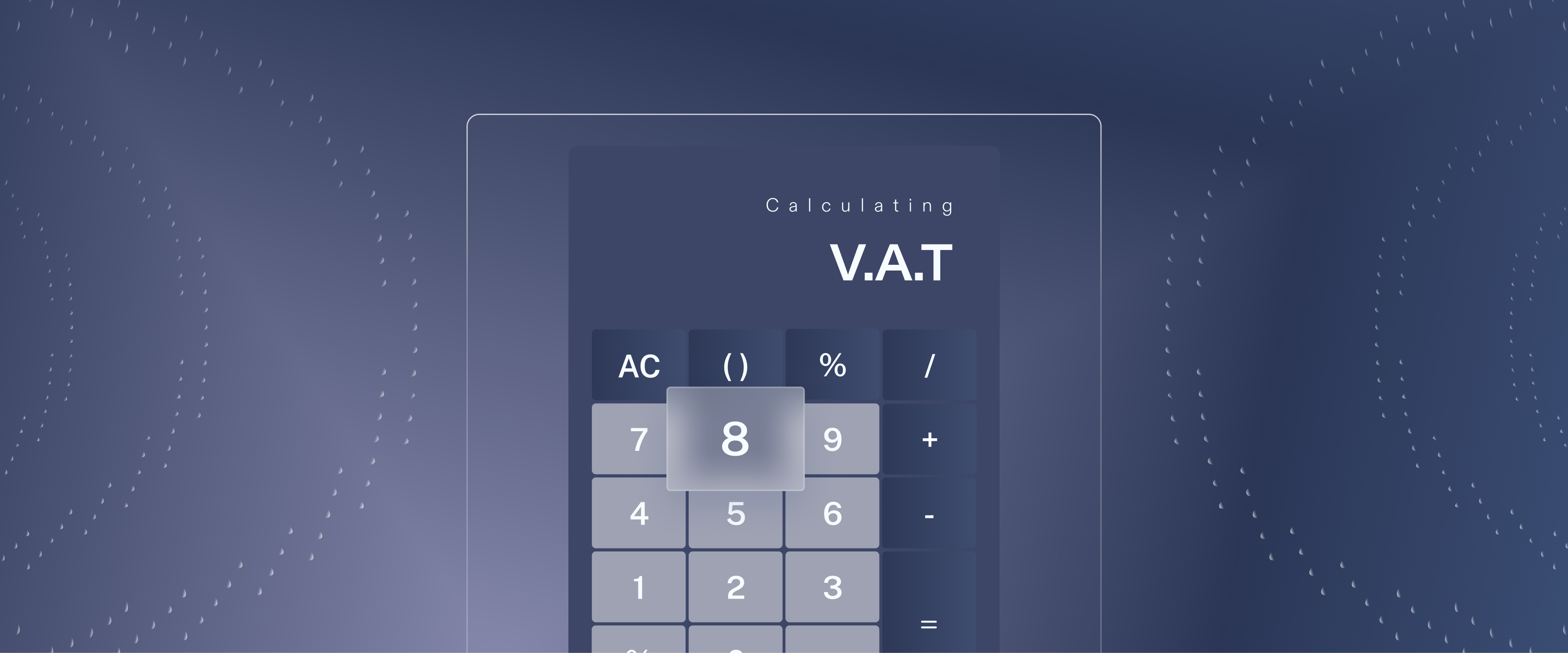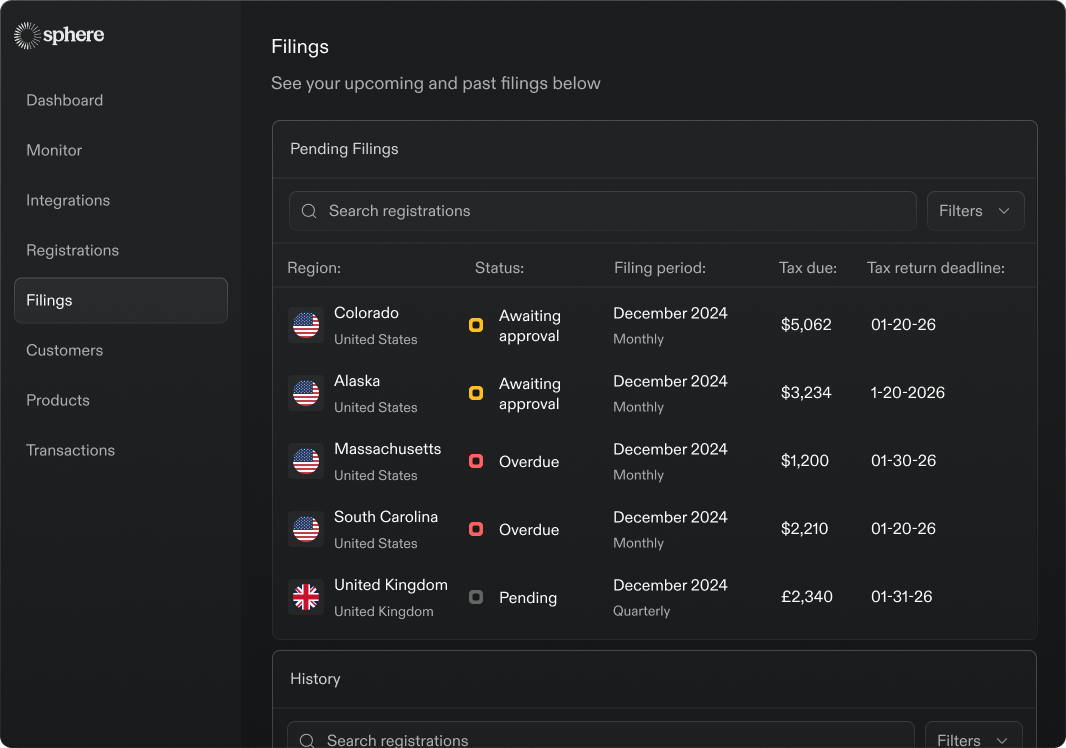
One of the many challenges of expanding into global markets is grappling with VAT. VAT shouldn't be an afterthought for your SaaS or AI company, because it affects how you price, invoice and even scale globally.
And as cross-border digital sales rules tighten, VAT mistakes can cause your big cross-border expansion to fizzle out before you even get started. Failing to charge the right rates, missing out on registration requirements, and paying VAT when you shouldn’t have to, all cut into your bottom line.
Here’s your step-by-step guide to when and how to charge VAT so you can get back to the profitable parts of running your business.
What Is VAT and How Does It Work?
Value-added tax (VAT) is a consumption tax on goods and services paid by the buyer at every stage of the supply chain. 170+ countries around the world use a VAT system to indirectly tax consumption.
VAT vs. US Sales Tax
Sales tax is an indirect tax and the US’s version of consumption tax. Sales tax is charged at the point of sale to the product’s (or sometimes service’s) end consumer. Unlike with VAT, no sales tax is charged between raw goods suppliers, manufacturers, wholesalers, and retailers, only the end customer who keeps, uses, or consumes the final product pays the tax.
Now that commerce is becoming more global, US-based businesses who have grown accustomed to dealing with sales tax find themselves having to learn a whole new tax system: VAT.
Where and When VAT Applies
VAT applies to most products and services. As a US-based software as a service (SaaS) or AI business, you’re likely to run into VAT once your customer base broadens globally. Many countries with VAT, for example, require that any business selling digital goods to a consumer in their country collect VAT starting from the very first sale.
Now that it’s so easy to sell digital products or SaaS services to anyone in the world, businesses often find themselves dealing with the obligation to register for and collect VAT before they’re prepared.
Also, just like with US sales tax, some items are non-taxable when it comes to VAT. These exempt or zero-rated items are not subject to tax just like items like groceries and medicine are not taxable in most US states. However, digital products and services are taxable in most countries with VAT.
Key VAT Concepts You Need to Understand
Though both are consumption taxes, how VAT is administered is significantly different from US sales tax.
Output VAT vs. Input VAT
Because VAT is charged and paid at all points on the supply chain, it’s important for businesses to keep track of both how much VAT they pay on a purchase and how much VAT they charge when selling their product or service.
The VAT your business pays when making a purchase is called input VAT. The VAT your business charges to customers is called output VAT.
When it comes time to remit VAT collected to taxing authorities, your business calculates Output VAT minus Input VAT to get your total amount of VAT due. This is the core formula used for VAT returns.
Zero-Rated vs. Exempt Supplies
Your business is not required to charge VAT on all sales. However, there is a difference between supplies that are “zero-rated” and supplies that are “exempt.”
Zero-rated supplies are technically subject to VAT, but the VAT is “charged” at 0%. Because of this distinction, businesses can still reclaim any input VAT they paid on their VAT returns.
VAT rules depend on each country, but food, children’s clothing, books, and exports are a few examples of items that are often zero-rated.
On the other hand, exempt supplies are not subject to VAT at all. And because of that, businesses cannot claim any input VAT tax credits when purchasing VAT exempt items. Exempt “supplies” often include services like medical care, education and some financial services.
Reverse Charge Mechanism
The VAT reverse charge mechanism was implemented to assist in the flow of commerce across borders.
In some cases, businesses are not required to register for VAT in a country because they have no physical presence there and sell exclusively to businesses in that country. In this case, under certain conditions, these businesses can issue an invoice stating that the “reverse charge” applies. The seller in that case, does not charge VAT to the buyer, and then does not have to collect, report and remit VAT on that transaction.
The buyer instead self-assesses the VAT that would have been due on the transaction in their own local VAT return. This way, the VAT is paid, but the out-of-jurisdiction seller who isn’t required to collect VAT does not have to collect money during the transaction.
Reverse Charge Example:
A SaaS company based in the US sells a year’s worth of services to another company based in Hungary. In this case, the supplier in the US can apply the reverse charge mechanism. The buyer in Hungary will be responsible for reporting and remitting the VAT due over the transaction in their own Hungarian VAT return.
Place of Supply Rules
When it comes to charging VAT in the EU, “place of supply” rules determine which VAT rate applies and who collects and remits that VAT.
However, this changes based on the product you are selling (i.e. goods, services, etc.) and whether you are selling B2B or B2C.
For physical goods:
- If goods are supplied without transport, the place of supply is where the goods are located when made available to the buyer.
- If goods are supplied with transport (shipment within the EU), the place of supply is where the transport of the goods begins.
- For intra-EU distance sales to consumers, the place of supply is generally where the transport of the goods ends (customer’s country). However, if the supplier’s cross-border sales are below a threshold of EUR 10,000 per year, the place of supply remains where the transport begins, unless the supplier opts to follow the general rule.
- For imported goods, the place of supply is where the goods enter the EU for customs clearance and subsequent sale. Note that place of supply also depends on when the customer takes title to the goods. This can affect who is responsible for the import VAT and duties.
For services (e.g. tax consulting):
- For B2B services (i.e. where a valid VAT number is collected from the customer), the place of supply is generally where the customer is established. The business receiving the service is responsible for accounting for VAT, typically via the reverse charge mechanism.
- For B2C services, the general rule is that the place of supply is where the customer is located.
- There are numerous special rules and exceptions for certain services (e.g., services related to immovable property, passenger transport, live online events), which may override the general rules. For example, services directly related to real estate are taxed where the property is located; since 2025, live online B2C events are taxed based on the customer’s location rather than the supplier
For digital goods/services:
- For B2C (selling to consumers), VAT is due in the EU country where the customer is located, and suppliers must charge local VAT at the point of sale.
- For B2B (selling to businesses), the place of supply is where the business customer is established, with VAT handled under the reverse-charge mechanism.
- Sellers (EU and non-EU) must collect evidence of the customer's location and are encouraged to use the One Stop Shop (OSS) system to simplify VAT registration and reporting for all EU cross-border digital sales.
The key points about “place of supply”:
- The place of supply rules ensure that VAT is accounted for in the correct EU Member State.
- Both goods and services are subject to special rules and exceptions depending on the precise nature of the supply.
- It is essential for businesses engaging in cross-border transactions to determine the correct place of supply to avoid penalties and ensure proper VAT compliance
VAT Refunds
When VAT input exceeds VAT output then your business may be entitled to a VAT refund. If VAT registered in a country/jurisdiction, you can claim the refund on your normal tax filing.
Businesses who are not required to be VAT registered in a VAT country, your business can still claim a VAT refund if you paid VAT. However, this process is more complicated as you have to register with that country’s separate VAT refund scheme. Note that these schemes often have a minimum refund amount you can request and strict deadlines for filing claims.
Despite the administrative hoops to jump through, countries doing business cross-border and who pay VAT should track refund eligibility. With VAT rates as high as 27% in some places, refunds can present a significant savings.
How to Calculate VAT (Step-by-Step Guide)
US-based businesses will find that calculating VAT is similar to calculating sales tax.
Step 1: Identify the Net Price
The net price is the price tag of the good or service before any VAT is applied. This is the starting point for all VAT calculations.
Step 2: Find the Correct VAT Rate
Check official tables to determine the VAT rate at the place of supply. Don’t forget to check for reduced rates, or zero-rated or exempt goods and services.
Step 3: Apply the VAT Rate
Use the formula:
VAT = Net Price x VAT Rate
For example, if you are selling an item with a net price of 100 € to a customer in a country with a VAT rate of 20%, apply the following:
100 € x 0.20 = 20 €
20 € is the total VAT charged.
Step 4: Add VAT to the Final Price
Add the VAT to the net price to get the total. Use the formula:
VAT + Net Price = Gross Total
In our example above, you’d add 100 € + 20 € and get a gross total of 120 €.
Step 5: Account for Input VAT
Always subtract input VAT paid on purchase from output VAT charged to determine how much VAT you owe (or if you are due a refund.)
Say you collected 2,500 € in VAT and paid out 1,800 € in VAT. You’d owe 700 € in VAT on your next VAT filing.
Real-Life Examples of VAT Calculation
Example 1: B2C SaaS Subscription
Your US-based SaaS company sold a $1,000 package to a buyer in Germany, which has a 19% standard VAT rate.
The net price is $1,000.
The net price x the VAT rate of 19% is $190.
The net price + the VAT total is $1,190.
You’d charge your customer a total of $1,190.
Note that most VAT countries have tax inclusive pricing which means that the price you show on your website or in your store front needs to be the price they pay at checkout (including tax). As such, sellers tend to gross up their pricing in VAT countries to account for this tax inclusive pricing.
Example 2 – Physical Goods Sale
Your US-based consumer electronics store sells a $500 laptop to a consumer in the UK. Since the laptop is an import to the UK, import VAT is due. In this case, unless you choose to handle VAT, your UK customer is responsible for paying customs duties and import VAT.
If you are not registered to collect VAT in the UK, then the buyer is responsible for paying the $500 to you, and then paying the 20% UK VAT rate on that $500 purchase directly to the UK taxing authority before they can take possession of the item after it has arrived in the country.
Example 3 – B2B SaaS with Reverse Charge
Your US-based SaaS company sells a $5,000 software package to a German business, but you have no VAT obligation in Germany. Since you are not required to charge VAT, you can verify that your customer is a VAT registered business and then apply the reverse charge mechanism.
The customer then self-reports the VAT. No money changes hands between you and the business customer.
What Makes VAT Compliance So Complex
Many businesses who have grown accustomed to US sales tax or other countries’ goods and services tax (GST) may find themselves mystified when dealing with VAT for a number of good reasons.
VAT Rates, Exemptions, and Thresholds Vary Widely
Though the VAT system is uniform in that tax is paid throughout the supply chain, it varies in many other ways.
Rates can vary from 5% to 27%. Some countries require B2C sellers to register from the first sales, while others have more forgiving minimum sales thresholds before requiring registration. And countries make their own rules about what is charged a reduced VAT tax rate, and what is zero-rated or exempt. This can even vary within the EU, which is generally considered a fairly uniform governing body.
Teams struggling to adapt to VAT can quickly get overwhelmed sorting out registration thresholds and VAT rates.
Managing Cross-Border Complexity
It’s now easier than ever to expand your customer base to all corners of the globe. But expanding too fast can leave you in a tax compliance quagmire. Every time you make a sale into a new country, you must learn a new set of tax compliance rules. In many cases, you only have a set time period to get registered for VAT before you're subject to penalties and interest.
For fast growing SaaS and AI companies, manually tracking VAT rates, rules, and thresholds becomes risky fast.
Automate What You Can
VAT compliance can be overwhelming. Sphere is here to help.
Sphere is the platform built for fast-growing SaaS companies who need to conquer cross-border tax compliance, even with a small-but-mighty finance team. (Which might even be made up of one individual who also wears nine other hats.)
This real-time tax engine integrates with your billing system and ensures you charge the right VAT rate every time. It also warns you if you have, or are about to, reach a country’s VAT registration threshold. And Sphere will even register for you.
And Sphere covers more than 50 countries, meaning you’ll likely find support for the markets in which you sell. Don’t lose sleep over what you don’t know when it comes to VAT. Find out more about Sphere.
Don’t Let VAT Hold Back Global Growth
Successfully managing VAT means registering when required, charging the right rates on the right products, and ensuring you don’t leave money on the table by failing to reclaim your VAT refunds.
And VAT isn’t just a last minute administrative hassle. VAT rates affect pricing, margins, and where you choose to focus your expansion efforts.
Don’t spend valuable time where you could be growing your business on learning new VAT systems. Let Sphere take VAT off your plate.








.png)
.png)
.png)





